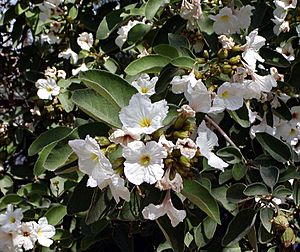Cordia facts for kids
Quick facts for kids Cordia |
|
|---|---|
 |
|
| Cordia boissieri in bloom | |
| Scientific classification |
|
| Kingdom: | Plantae |
| Clade: | Tracheophytes |
| Clade: | Angiosperms |
| Clade: | Eudicots |
| Clade: | Asterids |
| Order: | Boraginales |
| Family: | Boraginaceae |
| Subfamily: | Cordioideae |
| Genus: | Cordia L. |
| Type species | |
| Cordia myxa L.
|
|
| Species | |
|
See text |
|
| Synonyms | |
|
Cerdana Ruiz & Pav. |
|
Cordia is a group of about 300 different kinds of flowering plants. These plants are part of the borage family, called Boraginaceae. You can find them all over the world, especially in warmer places. They grow as shrubs or trees.
Many Cordia species are known as manjack. Some types from Central America are called bocote in Spanish. The name Cordia was given to honor a German botanist and pharmacist named Valerius Cordus. Like most plants in the borage family, many Cordia plants have tiny hairs, called trichomes, on their leaves.
Contents
Discovering Cordia Plants
The way Cordia plants are grouped and named can be tricky. This is because some types of Cordia plants look very different from each other, even within the same group. This makes it hard for scientists to identify them. Also, some new types were named based on plant samples that were not well preserved.
Popular Cordia Species
There are many interesting Cordia species around the world. Here are a few examples:
- Cordia africana – Also known as White manjack.
- Cordia alliodora – Called Spanish elm or Ecuador laurel. You can find it in the Neotropics.
- Cordia boissieri – Known as Anacahuita or Texas olive. It grows in southern Texas and northern Mexico.
- Cordia curassavica – Often called Black sage or wild sage.
- Cordia dentata – Another type of White manjack.
- Cordia dichotoma – Known as Fragrant manjack or bird lime tree. It grows in tropical Asia and Australasia.
- Cordia leucophlyctis – This plant is special because it only grows in the Galápagos Islands.
- Cordia lutea – Called Yellow cordia. It grows in western South America, including the Galápagos Islands.
- Cordia monoica
- Cordia myxa – Known as Assyrian plum. It is found in South Asia.
- Cordia platythyrsa – This is the West African cordia.
- Cordia rupicola – Called Puerto Rico manjack. It grows in Puerto Rico.
- Cordia sebestena – Known as Geiger tree. You can find it in southern Florida, the Greater Antilles, and Central America.
- Cordia sinensis – Also called Grey-leafed saucerberry.
- Cordia subcordata – Known by names like Kou or tou. It grows in Africa, South Asia, Southeast Asia, northern Australia, and the Pacific Islands.
- Cordia sulcata – Called Mucilage manjack or wild clammy cherry.
Cordia in Nature
Cordia plants are an important food source for some caterpillars. For example, the caterpillars of certain Lepidoptera (moths and butterflies) like Endoclita malabaricus and Bucculatrix caribbea eat Cordia leaves. The wild olive tortoise beetle also enjoys feeding on several Cordia species.
How People Use Cordia Plants
Cordia plants are used by people in many different ways.
Beautiful Garden Plants
Many Cordia species have lovely, fragrant flowers that stand out. This makes them popular choices for gardens. Even though they might not be super tough in all climates, their beauty makes them a favorite for many gardeners.
Tasty Fruits
Some Cordia species that grow in tropical areas have fruits that you can eat. These fruits have many different names, like clammy cherries, glue berries, or snotty gobbles.
In India, people use the fruits of local Cordia species as a vegetable. They can be eaten raw, cooked, or made into pickles. One example is the fragrant manjack (Cordia dichotoma). Its fruit is called gunda or tenti dela in Hindi. In Taiwan, the fruit is called phoà-pò·-chí and is often eaten pickled.
Natural Glue
The fruits of Cordia plants have a white, sticky inside. This gooey part has been traditionally used to make glue. It's a natural way to stick things together!
Valuable Wood
The wood from several Cordia species is very useful and is harvested for different purposes. For example, the wood from Ecuador laurel (Cordia alliodora), ziricote (Cordia dodecandra), and Spanish elm (Cordia gerascanthus) is used to make furniture and doors in Central and South America.
Ziricote and bocote wood are also used to make parts of high-quality acoustic guitars. This is because the wood has special sound qualities, making it a great tonewood. Drums are also made from Cordia africana and Cordia platythyrsa wood because of how well the wood resonates and carries sound.
Gallery
See also
 In Spanish: Cordia para niños
In Spanish: Cordia para niños




